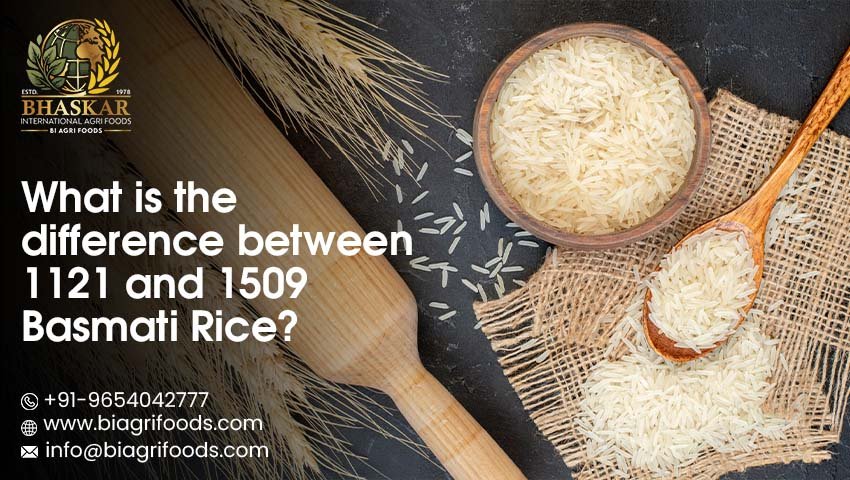
What is the difference between 1121 and 1509 Basmati Rice?
Basmati rice is commonly featured in Indian kitchens and global retailers around the world for its aroma, tenderness, and long distinct grains. But within the many varieties of Basmati, two varieties frequently raise discussion and intrigue, 1121 and 1509 Basmati Rice.
Both varieties are distinctly known in many countries across the world, for their unique characteristics and different uses of whole types of cooking, edible preference, and exported variety. As either a 1121 Basmati Rice Export, food lover, or someone simply wanting the best 1509 Basmati Rice Suppliers, understanding the differences allows for better choices.
Origin and Development
- 1121 Basmati Rice: Introduced in the early 2000s, 1121 was an awesome variety for its extra-long grains and fantastic elongation after cooking.
Most 1121 is grown in Punjab, Haryana and western Uttar Pradesh and is one of the most extensively exported varieties of Basmati rice.
- 1509 Basmati Rice: 1509 was released after 1121, and is a hybrid derived from two varieties of 1121 that have specific physiological advantages including shorter crop maturity and lower water requirement.
Grown in the same Northern states of India as 1121, 1509 and has become a farmer favorite for having early maturity rate and for improved yields.
| Feature | 1121 Basmati Rice | 1509 Basmati Rice |
| Grain Length (Raw) | 8.30 mm – 8.40 mm | 8.30 mm – 8.40 mm |
| Grain Length (Cooked) | Can raises up to 22 mm | raises up to 18-20 mm |
| Aroma | Strong traditional aroma | Slightly mild aroma compared to 1121 |
| Maturity Time | ~140-145 days | ~120 days |
| Water Usage | Requires more water | Requires less water (eco-friendlier option) |
| Yield | Slightly lower yield | Higher yield (beneficial for farmers) |
| Cooking Time | Takes slightly longer to cook | Cooks faster |
| Cost | Slightly higher due to premium grain and aroma | Economical and accessible |
| Export Demand | High demand due to elongation and fragrance | Increasingly popular due to lower cost and efficiency |
Which One Should You Choose?
1. Choose 1121 Basmati Rice if:
- You prefer aroma and grain length.
- You are planning to serve dishes like Biryani, Pulao or Zafrani Rice that depend on presentation.
- You are in the export business and targeting the premium international market.
2. Go For 1509 Basmati Rice if:
- You are looking for budget friendly option
- Need a quick cooking rice quality
- You are concerned with sustainable farming/rice production.
| Type of Dishes | Best with 1121 Basmati Rice | Best with 1509 Basmati Rice |
| Royal Biryani | Yes | Yes |
| Daily Steamed Rice | Slightly Expensive than others | Budget-friendly |
| Restaurant Serving | For premium offerings | For high turnover |
| Export Requirements | High preference | Growing demand |
Why do exporters and suppliers prioritize these varieties?
Both 1121 and 1509 are varieties that have excelled in export margin, as they are known for quality, purity, and shelf life.
1121 Basmati Rice Exporters have long been aware of the importance of packaging that is premium and meets international quality specifications. There is a segment of high-end buyers with difficult to satisfy demands for high quality packaging.
1509 Basmati Rice Suppliers benefit from high volume demand with a short crop turn around and lower production input costs, which makes the variety happen for new buyers in emerging global markets.
In conclusion,
It is helpful to understand the differences between 1121 and 1509 Basmati Rice to help make an informed choice in terms of taste, price, cooking/usage decisions, or farming purposes.
1121 provides top elongation and aroma ideal for finer dishes and exports, while 1509 provides flexibility, affordability, and sustainability.
Both varieties can be offered from a trusted source like BI Agri Foods...your trusted 1121 Basmati Rice Exporters, trusted 1121 Basmati rice Supplier, and dependable 1509 Basmati Rice Suppliers... from the fields of India to plates worldwide.

